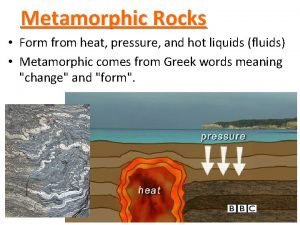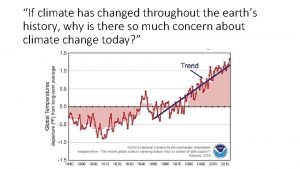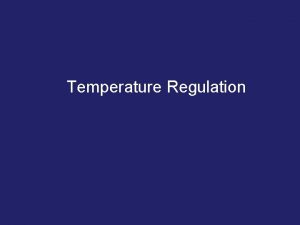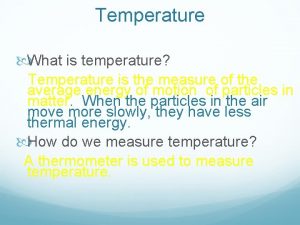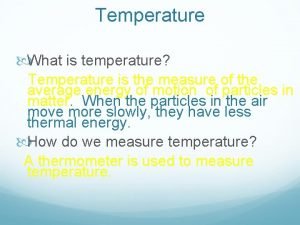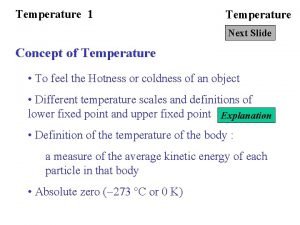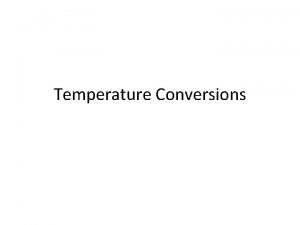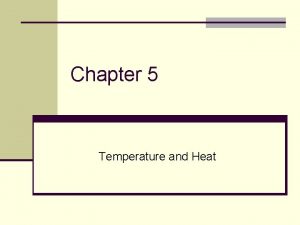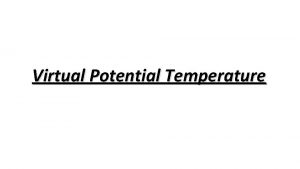Why has the temperature changed throughout history How













- Slides: 13

Why has the temperature changed throughout history? How do we know?

Why has the temperature changed throughout history? It can be changed through feedback effects Feedback effects are those that can amplify a change and make it bigger (positive) or smaller (negative). positive feedback is snow and ice cover. Small increase in snow and ice raises surface Albedo reflecting more solar energy back into space. Resulting in further cooling negative feedback s cloud cover. As global warming occurs, more evaporation occurs increasing cloud cover, which in turn may reflect more solar rays back into space diminishing effects of the warming

Know – there are both human and physical causes for climate change Understand – why some people view current climate change as unprecedented Skills – explanation, comprehension, note taking LEARNING OBJECTIVES & OUTCOMES A*-A Justify which cause, human or natural, they think is the cause of our changing climate. B-C Explain how natural D variations Describe affect the natural climate and reasons of assess climate change which hazards

1. Variations in the Earth’s Orbit Milankovitch Cycles • A Serbian physicist working at the beginning of the 20 th century developed a theory to explain periods of glaciation in recent history. • He identified 3 variations in the Earth’s orbit around the Sun Milutin Milankovitch This might explain the small variations in the earth’s temperature such as in the Middle ages. Until recently studying previous temperatures was not really possible, but with Ice core analysis it is now possible and there is support for his theory. 1879 - 1958

Earths orbit! Every 100, 000 yrs the Earths orbit changes from spherical to elliptical, changing solar input

Tilt of the Earth The Earth’s axis is tilted at 23. 5 o, this changes over a 41, 000 yr cycle between 22 o & 24. 5 o, affecting solar input, especially in higher latitudes.

Wobbly axis! The Earth’s axis wobbles, so which way the hemispheres are facing to the sun when closest to the sun varies over 21, 000 yrs. Affecting solar input.

• Until recently Milankovitch’s had no real support from past climate history. • However, from measuring ice cores these now support this theory. • Many scientists argue that the Milankovitch cycle may have been just enough to trigger a major global climate change, but that climate feedback mechanisms are needed to sustain it

2. Variations in Solar Output • The sun’s output is not constant is also varies. A variety of cycles have been detected, most are short term, the most obvious is due to sun Spot activity – 11 yrs • The effect of sunspots is to blast more solar radiation towards the earth • Some scientists have suggested that around 20% of 20 th Century warming may be because of solar output variation

3. Volcanoes • Major eruptions eject material into stratosphere. • The sulphur dioxide forms a haze of sulphate aerosols, which reduces the amount of sunlight received at Earth’s surface • The eruption of Tambora led to the year without a summer in 1816 as global temperatures dipped by 0. 40. 7°C • MT St Helens in 1980 and Mt Pinatubo in 1991 released huge quantities of volcanic dust which blocked out sunlight, and also caused increases in cloud cover and rainfall for 1 -2 years. US geological survey says by contrast humans produce 150 x the amount of CO 2 emitted by volcanoes.

Why has the temperature changed throughout history? Is the global warming we see now unprecedented – “never seen before”? Ø Sir David Attenborough Ø IPCC in 2007 sums up the current views on Global warming “The observed widespread warming of the atmosphere and ocean, together with ice mass loss, support the conclusion that it is extremely unlikely that global climate change of the past 50 years can be explained without external forcing, and very likely that it is not due to known natural causes alone”

So anthropogenic causes seem to be confirmed. Note down some of the recent facts to emphasize this! • 11 of the 12 warmest years on record occurred between 1995 • The level of CO 2 in the and 2006 atmosphere is far above the • Temperature rises have been ‘natural’ level and continues to rise. recorded on all continents since 1970 • Satellite observations since 1993 suggest an annual rise in sea level of 3. 1 mm, and a decline in Arctic sea ice of 2. 7% per decade

Plenary Hint: use years ad average number of sunspots per year to quote in your answer. Hint: look for tends in fluctuation. Does it go up, down or vary?
 The metamorphosis activities
The metamorphosis activities Regional metamorphism
Regional metamorphism Pictures
Pictures Throughout history people
Throughout history people Throughout history water
Throughout history water What does the picture depict
What does the picture depict What does the first apparition tell macbeth
What does the first apparition tell macbeth How has technology changed sports
How has technology changed sports How has technology changed our perception
How has technology changed our perception Has the exchange rate changed chapter 10
Has the exchange rate changed chapter 10 Has the exchange rate changed chapter 10
Has the exchange rate changed chapter 10 Difference between curie temperature and neel temperature
Difference between curie temperature and neel temperature Difference between curie temperature and neel temperature
Difference between curie temperature and neel temperature Ferromagneti
Ferromagneti

